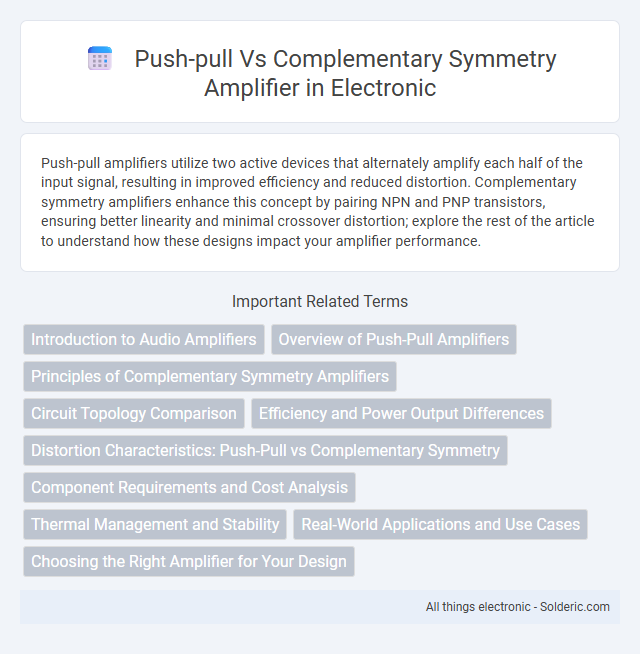Push-pull amplifiers utilize two active devices that alternately amplify each half of the input signal, resulting in improved efficiency and reduced distortion. Complementary symmetry amplifiers enhance this concept by pairing NPN and PNP transistors, ensuring better linearity and minimal crossover distortion; explore the rest of the article to understand how these designs impact your amplifier performance.
Comparison Table
| Aspect | Push-Pull Amplifier | Complementary Symmetry Amplifier |
|---|---|---|
| Transistor Types | Two identical transistors (both NPN or both PNP) | One NPN and one PNP transistor |
| Configuration | Symmetrical push-pull operation using matched transistors | Complementary pairing of NPN and PNP for push-pull |
| Efficiency | Moderate efficiency (typically Class B) | High efficiency (up to 78% for Class B) |
| Distortion | Higher crossover distortion due to transistor mismatch | Lower crossover distortion from complementary transistors |
| Biasing Complexity | Relatively simpler biasing | More complex biasing to avoid crossover distortion |
| Output Waveform | Good linearity with some distortion at zero crossing | Better linearity and smoother zero-crossing response |
| Applications | Basic audio amplification and power stages | High-fidelity audio amplifiers, power output stages |
| Heat Dissipation | Balanced heat distribution | Efficient heat management due to complementary action |
Introduction to Audio Amplifiers
Push-pull and complementary symmetry amplifiers are essential audio amplifier configurations that enhance signal fidelity and power efficiency. Push-pull amplifiers use pairs of transistors operating in opposite phases to reduce distortion and improve linearity, while complementary symmetry amplifiers employ matched NPN and PNP transistors to achieve balanced output and better thermal stability. Choosing the right amplifier design impacts your audio system's performance by optimizing sound clarity and minimizing harmonic distortion.
Overview of Push-Pull Amplifiers
Push-pull amplifiers use pairs of transistors or tubes to amplify both halves of an input signal, enabling efficient power delivery and reduced distortion. These amplifiers excel at canceling even-order harmonics, improving audio fidelity and overall linearity. Your audio system benefits from a balanced output and enhanced performance with push-pull designs.
Principles of Complementary Symmetry Amplifiers
Complementary symmetry amplifiers operate on the principle of using paired transistors, one NPN and one PNP, to amplify both halves of an input signal waveform efficiently. This design reduces crossover distortion commonly found in push-pull amplifiers by ensuring that each transistor conducts for precisely half the waveform cycle, allowing smoother signal transitions. Your audio performance benefits from improved linearity and higher power efficiency due to the complementary conduction of these transistors.
Circuit Topology Comparison
Push-pull amplifiers employ two active devices that alternately drive the load during opposite halves of the signal cycle, reducing even-harmonic distortion and improving efficiency. Complementary symmetry amplifiers utilize matched pairs of NPN and PNP transistors in a single stage to achieve better linearity and symmetrical output characteristics. The push-pull topology often requires phase splitting and careful biasing, while complementary symmetry designs offer simpler bias arrangements and inherently balanced operation.
Efficiency and Power Output Differences
Push-pull amplifiers typically achieve efficiency around 60-70% by using pairs of transistors that alternately conduct, reducing distortion and power loss. Complementary symmetry amplifiers use both NPN and PNP transistors to provide a balanced output stage, often resulting in slightly higher overall power output but with efficiency usually in the same range as push-pull designs. Your choice between these configurations impacts the trade-off between maximal power delivery and thermal management, crucial for optimizing amplifier performance.
Distortion Characteristics: Push-Pull vs Complementary Symmetry
Push-pull amplifiers exhibit lower even-order harmonics distortion due to their inherent cancellation of symmetrical signal components, resulting in cleaner audio output. Complementary symmetry amplifiers also achieve low distortion but tend to have slightly higher crossover distortion around the zero-crossing point because of transistor switching delays. Your choice between these amplifier types affects the balance between harmonic distortion suppression and crossover distortion performance.
Component Requirements and Cost Analysis
Push-pull amplifiers require fewer active components, typically a pair of transistors, making them cost-effective and simpler to design. Complementary symmetry amplifiers use both NPN and PNP transistors, increasing component count and overall expense but providing improved linearity and efficiency. The higher cost of complementary symmetry designs is balanced by their superior performance in reducing distortion and power consumption.
Thermal Management and Stability
Push-pull amplifiers offer improved thermal management by distributing heat dissipation across paired transistors operating in opposite phases, reducing thermal stress on individual components and enhancing overall reliability. Complementary symmetry amplifiers utilize matched NPN and PNP transistor pairs, providing balanced operation and minimizing crossover distortion, which contributes to stability under varying thermal conditions. Effective heat sinking and bias stabilization techniques are critical in both designs to maintain consistent performance and prevent thermal runaway.
Real-World Applications and Use Cases
Push-pull amplifiers are commonly used in audio power amplification where efficiency and distortion reduction are critical, such as in home theater systems and musical instrument amplifiers. Complementary symmetry amplifiers, leveraging matched NPN and PNP transistor pairs, excel in high-fidelity audio and RF amplification due to their excellent linearity and thermal stability. Choosing between these topologies impacts Your design's performance in applications requiring either robust power handling or superior signal clarity.
Choosing the Right Amplifier for Your Design
Selecting between push-pull and complementary symmetry amplifiers depends on factors such as efficiency, distortion levels, and complexity of implementation. Push-pull amplifiers offer improved power efficiency and reduced even-order harmonics by using two active devices driven out of phase, making them suitable for moderate power applications. Complementary symmetry amplifiers utilize matched NPN and PNP transistor pairs to achieve better linearity and lower crossover distortion, ideal for high-fidelity audio amplification where signal purity is critical.
Push-pull vs Complementary symmetry amplifier Infographic

 solderic.com
solderic.com